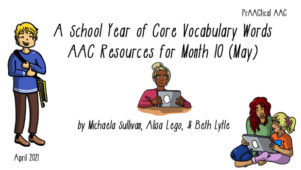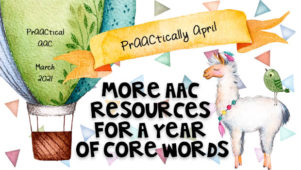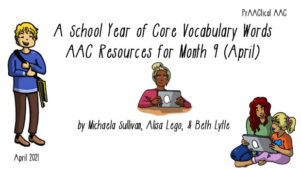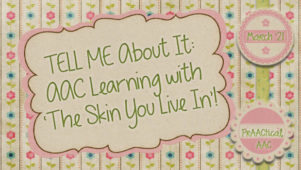How We Do It: Changing AAC Mindsets & Outcomes
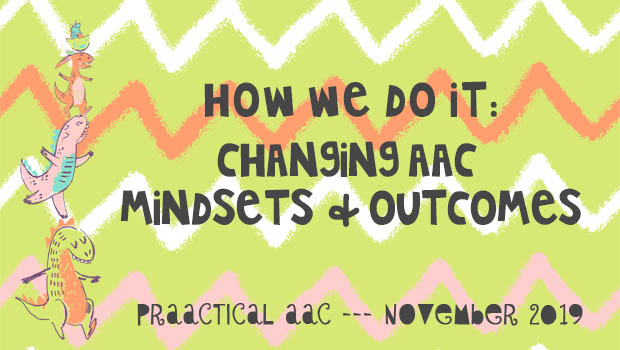
As AAC interventionists, we spend a lot of time helping therapists, teachers, families, and others develop their appreciation for multimodal communication and build their skills in using supportive strategies. In today’s post, Deidre Dobbels, a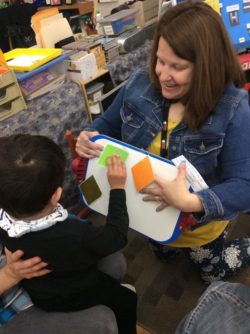 speech-language pathologist specializing in AAC, language and literacy development in young children, shares her thoughts on how we can do this effectively. Deidre is employed by Barrington CUSD #220 in the Northwest Suburbs of Chicago in which a Universal Core Approach to Language and Literacy has been in place for nearly a decade. Deidre authored a multi-media early developing core vocabulary curriculum used by her school district as well as by therapists and teachers throughout the Midwest. In her guest post, Deidre talks about her experiences in addressing the AAC needs of young children with complex communication needs.
speech-language pathologist specializing in AAC, language and literacy development in young children, shares her thoughts on how we can do this effectively. Deidre is employed by Barrington CUSD #220 in the Northwest Suburbs of Chicago in which a Universal Core Approach to Language and Literacy has been in place for nearly a decade. Deidre authored a multi-media early developing core vocabulary curriculum used by her school district as well as by therapists and teachers throughout the Midwest. In her guest post, Deidre talks about her experiences in addressing the AAC needs of young children with complex communication needs.
Changing Mindsets, Changing Outcomes
As a young Speech Language Pathologist working in Early Childhood classrooms, I was eager to grow my student’s vocabularies. I saturated every moment and every environment with words. Apple, core, stem, seed. Chair, table, markers, glue. I sent home picture vocabulary boards weekly for parents to go over at home. And it worked – for most students. Updating my student’s goals at the end of a marking period, I was able to proudly and empirically state that they had increased their vocabularies by x number of words. My assessment procedure went something like this: following two weeks of apple, core, stem, seed, repeat… I would point to a picture on my unit vocabulary array and say “what is it?” I tallied and calculated percentages. Check, check. Parents were pleased thinking I had accomplished my job of giving their kid “speech.” But then one parents said to me, “I have no idea if my kid even likes apples. He can’t tell me.” It hit me like a ton of bricks. I had thought I was doing what my students needed – that more words equated to more to say. I will always remember sitting in that conference room, the hum of the fluorescent light and the smell of wet boots lingering from the hallways on that mid-winter afternoon. This became a defining moment in my early career.

Before I knew what core vocabulary or descriptive teaching was, I was changing up my intervention methods. As I had in years before I sat before my gaggle of cube chair sitting preschoolers holding a shiny red apple. Instead of apple, core, stem, seed, I offered the following: you eat it, I like it, I don’t like it, help me get it, I want more, come see it. As in years before, we tasted apples, we cut the apples in half to see the little star inside, we compared and contrasted big apples and little apples, red and yellow and green apples. The activities remained the same, but the words I chose to bombard my students with changed. I felt I was heading in the right track.
As a Speech Language Pathologist, I generally do not plan or carry out the general curriculum for my students. I am a resource and support staff to my teams and work to increase the skills of my students so that they are able to access the curriculum making modifications as necessary. One of the most challenging aspects of my job was being a collaborative supportive team member while simultaneously trying to shift the focus away from labeling nouns to authentic and meaningful communication.
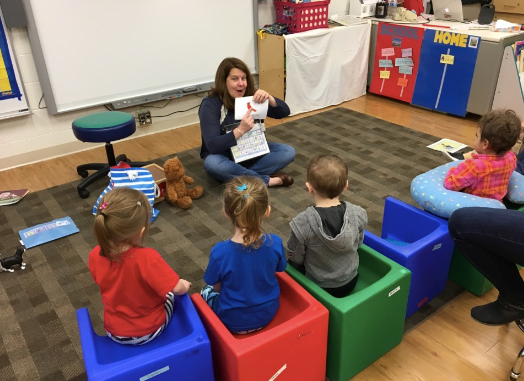
I was assigned to a new classroom with a seasoned and well-respected teacher. At a rare moment when I sat around a table co-planning an upcoming unit on the grocery store & cooking, I bravely asked what outcomes the teacher wanted to see at the end of the unit. She said she would like students to be able to identify foods that belong in a variety of categories; fruits, vegetables, dairy, and meats. Putting my fear of my co-worker thinking I was being critical of her pedagogy and damaging our relationship aside, I pushed on and explained that my goal was for my students to communicate whether they have tasted the foods, if they would like to try them, if they like the foods, and create a narrative to tell me how to make the food. I asked if we could pair together the groups of food words with a small set of carrier phrases (they were “core” and I didn’t know it!) She agreed and our collaboration began. As she introduced each fruit I asked questions and tallied responses on a large sheet of butcher paper. “Do you like to eat oranges?” I asked. I marked an x under each response stating “Jimmy does not like to eat oranges.” “Becca likes to eat oranges.”
Later in the week, we squeezed oranges into cups making orange juice. I took a quick picture of each child. When I returned to the classroom the next time, I had printed out pictures of each child and created a quick book, with a quick repetitive phrase under each photo: “Sara is making it. Jamir is making it. Ryan is making it. Javier is making it. Jenna is making it….” My final page was a picture of the glass of orange juice we made (man does it take a lot of oranges to make a glass of OJ!) and the words “They made orange juice.” I placed the book in the library area. It became a popular choice during “pick a book time.” I’d hear little voices approximating the phrases. My teacher co-worker did as well. We smiled. We introduced many fruits and vegetables throughout the two weeks using the same butcher paper tally chart and language script. Instead of sending home just a sheet of pictures, we also sent the carrier phrases and asked the parents to engage their child into an activity of cutting apart the pictures and placing them to the corresponding carrier phrase. I like apples. I don’t like zucchini. With one slight collaborative modification, my co-worker and I began our journey away from Noun Town.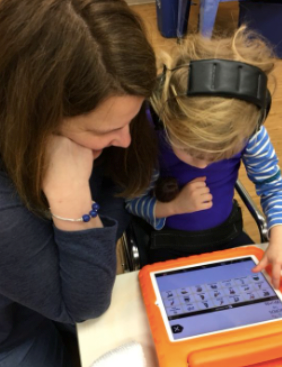
Nearly a decade after I began my career, I met Kelly Key who was the Assistive Technology Coordinator at my new school district. She was enthusiastically leading a new staff orientation in-service on Core Vocabulary. I nodded my head so vigorously throughout her talk that my neck got sore. She had a name for what I did! And an enthusiasm that was catchy. I was so excited to be in a district where a Universal Core Focus was forefront (To learn more about the Universal Core Approach for Language and Literacy at Barrington IL CUSD #220, check out this link.)
Throughout my career, the small incremental changes like the butcher paper charts have been my most successful actions in changing mindsets. I wholeheartedly believe every child should have access to and continuous aided language stimulation of a robust core-based vocabulary. In viewing my role as a collaborative partner of a multi-disciplinary team who comes to the table with a variety of backgrounds, experiences, and focus, this often has meant starting small.
One of my easiest ways to introduce core into classrooms is by introducing a song of the week that target core words. (You can access my 16 original all core songs for free here for a limited time. Introduce the song, pass out the core boards, and model away. Ask your co-workers to play the song (1-2 minutes) each day. Warning: the songs are repetitive and stay with you (by design). You may end up with a break room full of staff members humming the tunes and thinking in core. (Score!)
For those of you who are core warriors…tirelessly copying core boards and training every staff member who will give you 5 minutes… those passionately modeling core while hanging out in Noun Town… those who are up against the naysayers or the ‘we’ve-always-done-it-this-way-ers’… I see you and you are making a difference. Don’t stop believing! (Gosh I love Journey!)
Filed under: Featured Posts, PrAACtical Thinking
Tagged With: core vocabulary, schools
This post was written by Carole Zangari

